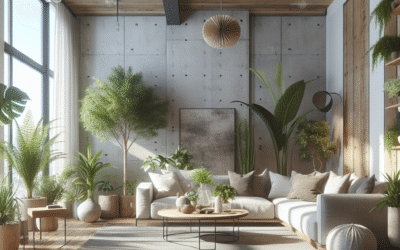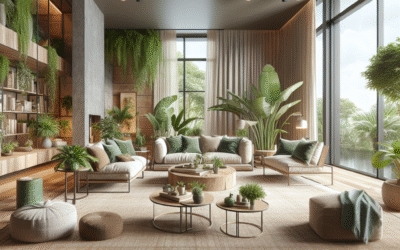
Embracing Serenity: How Softer Tones Transform Your Relaxing Spaces
Imagine coming home after a long, hectic day. You walk through the door and are greeted by soft, calming hues that instantly put your mind at ease. This isn’t just a fantasy; it’s the transformative power of softer tones in your relaxing spaces. In our fast-paced, often chaotic lives, creating a serene sanctuary is essential for mental well-being.
This article will dive deeper into the concept of using softer tones to enhance the tranquility of your spaces. You’ll learn about the psychology behind colors, practical steps for incorporation, and real-world examples that illustrate the impact of a softer palette. By the end, you’ll have a roadmap for turning your home into a soothing environment that promotes relaxation and peace.
The Psychology of Color: Understanding Softer Tones
Your environment plays a pivotal role in how you feel. Softer colors like pastel blues, gentle greens, and muted grays can foster a sense of calm and clarity. According to color psychology, these tones can reduce stress, improve your mood, and create a warm, inviting atmosphere.
Case Study: The Impact of Color on Stress Levels
A study conducted by the University of British Columbia found that individuals exposed to softer color environments reported lower stress levels than those in bright, vibrant settings. This highlights the significance of color selection when designing your relaxing spaces.
Actionable Insight
- Identify the colors that resonate with your personal sense of calm.
- Testing color samples in your home before making a commitment ensures you love the hue.
Creating a Soothing Color Palette
Building a harmonious color palette is essential for creating relaxing spaces. Aim for a balance between soft hues to maintain tranquility.
Choosing the Right Base Color
Start with a base color that is neutral—think soft whites or pale grays. These colors provide a tranquil foundation that allows you to build further with accent tones.
Accent Colors and Textures
Incorporate soft blues or muted greens as accent colors. Pair these with textures like soft fabrics and natural materials for added warmth. For instance, a soft blue throw on a neutral sofa can evoke a sense of peace.
Actionable Insight
Use online design tools like Color Hunt or Coolors to create your soft palette before starting any painting or decorating.
Implementing Softer Tones in Different Spaces
Now, let’s explore how to implement these soft tones in various areas of your home.
Bedrooms: Your Personal Sanctuary
Be sure to focus on soft tones that promote sleep. Gentle greens, muted blues, and soft lavender can create a peaceful bedroom retreat.
Living Areas: Inviting Calmness
Your living area is often where you entertain guests. Utilize soft tones to foster a welcoming environment. Soft neutrals paired with pastel accent pillows can strike the perfect balance.
Kitchen Spaces: Light and Airy
Consider a softer white or beige for cabinetry, along with pastel accents in wall art or dishware. This creates an inviting and open space that feels less cluttered.
Actionable Insight
Each room should reflect the desired mood. Designate areas for soft furnishings and wall appointments that enhance tranquility.
Natural Elements and Their Importance
Beyond color, incorporating natural elements can further enhance your relaxing spaces.
Incorporating Plants
Indoor plants not only purify the air but also introduce calming green tones. They are an effortless way to harmonize your interior with nature.
Using Natural Light
Maximize natural light to enhance soft colors. Use sheer curtains to filter sunlight without completely blocking it, maintaining a bright and airy feel.
Actionable Insight
- Consider houseplants like peace lilies or snake plants that thrive indoors.
- Use mirrors to reflect light and create a more spacious atmosphere.
Maintaining Serenity: Practical Steps for Longevity
Once your relaxing space has been established, how do you maintain its tranquility?
Regular Decluttering
A cluttered space can disrupt peace. Regularly assess what items truly bring you joy and clear away the rest.
Mindful Practices
Incorporate mindfulness into your daily routine in your serene spaces. Consider practices such as meditation or yoga to enhance the calming effects of your environment.
Actionable Insight
Set aside time each week for a short cleaning ritual or a mindfulness practice in your designated relaxing spot.
FAQ
What are some examples of softer tones for home decor?
Softer tones include pastels like pale pink, light blue, soft lavender, and muted greens. These colors create a calming atmosphere.
How can I choose the right colors for my space?
Consider the mood you want to create. Testing color swatches in different lighting throughout the day is a smart approach.
Can softer tones work in small spaces?
Absolutely! Softer tones can make small spaces feel larger and more inviting. Use light colors on walls and furniture.
How do I incorporate natural elements into my relaxing space?
Add potted plants, use natural materials in furniture, and let in natural light through windows.
Should I mix softer tones with vibrant colors?
While it’s possible, be cautious. Softer tones can be overwhelmed by vibrant colors. Use vibrant hues as accents instead.
Conclusion: Embrace Your Serenity
Creating a relaxing space filled with softer tones can significantly enhance your mental well-being. By understanding color psychology and applying actionable strategies, you can transform your home into a serene haven.
Now that you have a roadmap, it’s time to act! Begin implementing these insights and embrace the calming environment you’ve always envisioned.
For more tips on creating a peaceful home, check out our related articles on home decor and mindfulness.
Content Disclaimer
The information provided in this article is for educational purposes only and should not be taken as professional advice. Consult experts for specific guidance tailored to your needs.
Categories
- Accent Walls & Ceilings (61)
- Art Curation & Gallery (62)
- Bedding Style Trends (68)
- Bedroom Makeover (81)
- Bohemian & Eclectic Styles (58)
- DIY & Budget-Friendly Decor (64)
- Eco-Friendly Design (62)
- Furniture Care (71)
- Home Decor & Design Ideas (162)
- Home Wellness Spaces (59)
- Integrated Outdoor Living (67)
- Japandi Style (61)
- Kids and Nursery Decor (59)
- Living Room Decor (79)
- Mix & Match Techniques (73)
- Modern & Contemporary Design (66)
- Rug Sizing & Placement (73)
- Scandinavian Design Inspiration (20)
- Seasonal Home Decor (79)
- Small Space Solutions (73)
- Wall Art & Painting Tips (77)
Recent Comments
Archives
Product Gallery
-
Large Area Green Rugs for Bedroom Nordic Living Room Decoration Shaped Carpet Irregular Plush Lounge Rug Home Thick Washable Mat
Rated 5.00 out of 5$36.00 – $225.00Price range: $36.00 through $225.00 -
Nordic Style Rugs for Bedroom Morandi Living Room Decoration Carpet Large Area Geometry Lounge Rug Home Cloakroom Non-slip Mat
Rated 5.00 out of 5$26.00 – $388.00Price range: $26.00 through $388.00 -
Irregular Shapes Living Room Decoration Carpet Modern Style Rugs for Bedroom Home Thicken Plush Rug Fluffy Soft Lounge Floor Mat
Rated 4.83 out of 5$37.00 – $226.00Price range: $37.00 through $226.00














